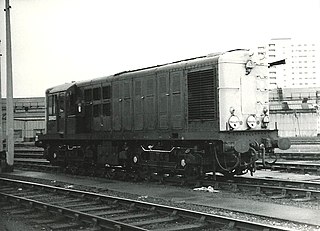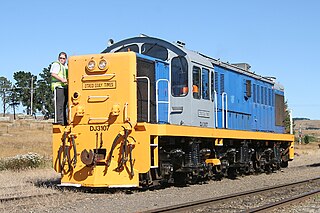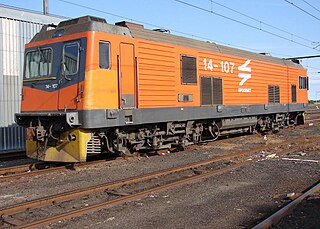
The SD80MAC was a 5,000 horsepower (3.7 MW) C-C diesel-electric locomotive. It was powered by a 20-cylinder version of EMD's 710G prime mover, and was the second diesel locomotive by GM-EMD to use a V20 engine, since EMD's SD45 series. It introduced a wide radiator housing similar to GE Transportation locomotives and the placement of dynamic brakes at the rear of the locomotive, which is a quieter location, features that were incorporated into the SD90MAC and SD70ACe models. Key spotting differences between the SD80MAC and SD90MAC include no external rear sandbox on the SD90MAC, no rear lighted number boards on the SD90MAC, and the placement of the front numberboards. The SD80MAC also had recessed red marker lights in the nose, an identifying feature unique to Conrail (CR) locomotives, although Norfolk Southern (NS) had removed the lights on most of their former Conrail engines.

A diesel locomotive is a type of railway locomotive in which the power source is a diesel engine. Several types of diesel locomotives have been developed, differing mainly in the means by which mechanical power is conveyed to the driving wheels. The most common are diesel-electric locomotives and diesel-hydraulic.

The British Rail Class 16 also known as the North British Type 1 was a type of diesel locomotive designed and manufactured by the North British Locomotive Company. A total of ten were produced, these being numbered D8400-D8409.

English Electric DP1, commonly known as Deltic, is a prototype 3,300 hp (2,500 kW) demonstrator locomotive employing two Napier Deltic engines, built by English Electric in 1955.

The Evolution Series is a line of diesel locomotives built by GE Transportation Systems, initially designed to meet the U.S. EPA's Tier 2 locomotive emissions standards that took effect in 2005. The line is the direct successor to the GE Dash 9 Series. The first pre-production units were built in 2003. Evolution Series locomotives are equipped with either AC or DC traction motors, depending on the customer's preference. All are powered by the GE GEVO engine.

Prima is a family of railway diesel and electric locomotives built by Alstom. Manufacture of the type commenced in the late 1990s. By 2008, Alstom had reportedly sold 1,750 Prima locomotives. The second generation Prima II was launched in 2009. The Prima H3 diesel/battery hybrid locomotive was launched in 2013.

NSB Di 4 is a class of five diesel-electric locomotives built by Henschel for the Norwegian State Railways (NSB). Delivered in 1981, the class is used to haul passenger trains on the Nordland Line and are since 2001 the only revenue diesel locomotives used by NSB. The locomotives had electric components from Brown, Boveri & Cie and a General Motors Electro-Motive Division 16-645E prime mover. This gives a power output of 2,450 kilowatts (3,290 hp) and a starting tractive effort of 360 kilonewtons (81,000 lbf).

The New Zealand DJ class locomotive is a type of diesel-electric locomotive in service on the New Zealand rail network. The class were built by Mitsubishi Heavy Industries and introduced from 1968 to 1969 for the New Zealand Railways Department (NZR) with a modernisation loan from the World Bank to replace steam locomotives in the South Island, where all of the class members worked most of their lives. Nine of the locomotives remain in use, mainly with Dunedin Railways.

The DF8 is a type of diesel locomotive used in China. It was in production from 1984 until mid-1990s, with mass production starting in 1989. The revised DF8B is still in production today. DF8 are almost exclusively used for freight services.
This page explains the numbering and classification schemes for locomotives employed by the Japanese Government Railways, the Japanese National Railways and the Japan Railways Group.

Rosebud Kitmaster is the brand name of a short-lived but critically acclaimed range of plastic assembly kits, manufactured in the United Kingdom by Rosebud Dolls Ltd of Raunds, Northamptonshire. Introduced from May 1959, the range rapidly expanded to include 34 models of railway locomotives and coaches in OO, HO and TT scales, and eventually, one motorcycle in 1:16 scale.

The Stadler Euro is a class of diesel-electric locomotives built by Stadler Rail for the European market. It is available in two basic variants, the four-axle Euro 3000, and the six-axle Euro 4000. These locomotives are powered by EMD 710 prime movers. A six-axle electric-only variant is marketed as Euro 6000; it is also built for the Iberian gauge.

The Blue Tiger is a type of high powered diesel-electric locomotive developed by ADtranz in association with General Electric.

The New Zealand DL class of diesel-electric locomotives was manufactured for KiwiRail by CRRC Dalian with engines from MTU. They are the most powerful diesel-electric locomotives in service in New Zealand.

The Spoornet Class 14E1 of 1994 was a South African electric locomotive.

The South African Railways Class 37-000 of 1981 is a mainline diesel-electric locomotive.

The Spoornet Class 39-000 of 2006 is a South African diesel-electric locomotive from the Spoornet era.

S-Motor was the class designation given by the New York Central to its ALCO-GE built S-1, S-2, S-2a and S-3 electric locomotives. The S-Motors hold the distinction of being the world's first mass-produced main line electric locomotives with the prototype #6000 being constructed in 1904. The S-Motors would serve alone until the more powerful T-motors began to arrive in 1913, eventually displacing them from main line passenger duties. From that point the class was assigned to shorter commuter trains and deadhead rolling stock between Grand Central Terminal and Mott Haven coach yard. Some examples, including the prototype later renumbered #100, would serve in this capacity through the Penn Central merger in 1968, only being retired in the 1970s as long distance passenger traffic to Grand Central dried up.

The Indian locomotive class WDM-4 is a class of diesel-electric locomotive that was developed in 1962 by Electro-Motive Diesel for Indian Railways. The model name stands for broad gauge (W), Diesel (D), Mixed traffic (M) engine, 4th generation (4). They entered service in 1962. A total of 72 WDM-4 locomotives were built between 1961 and 1962.

The Indian locomotive class WAG-6B/C is a class of 25 kV AC electric locomotives that was developed in the 1988 by Hitachi for Indian Railways. The model name stands for broad gauge (W), AC Current (A), Goods (G) engine, 6th generation (6) Second/Third variant (B/C). They entered service in 1988. A total of 12 WAG-6 were built at Hitachi, Japan between 1987 and 1988. they along with WAG-6A were the most powerful locomotives in India until the arrival of the WAG-9 class.



















